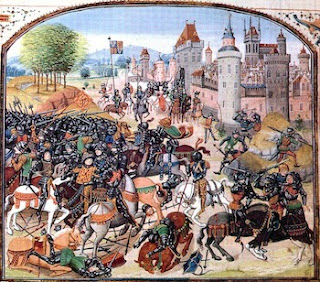Richard I built it in Normandy as a staging site for his war with Philip II of France, but died shortly after its completion. His younger brother and successor, John, was unsuccessful in defending his lands against Philip, and lost Gaillard along with Normandy in 1204.
After capturing several other Norman castles, Philip besieged Gaillard in September 1203. The castle might have survived a prolonged siege, being well-provisioned. The citizens of Andeli—the town that grew up at the base of the hill on which Gaillard was situated—fled to the castle to escape the Normans, and the additional mouths that needed food and water stretched the supplies thin. Furthermore, John did not send any troops that winter to help the garrison, and Gaillard fell into Philip's hand in March of 1204.
The castellan, Roger de Lacy, requested of the surrounding French that the civilians be given safe passage. Over the course of two days, about 1000 civilians departed the castle and went safely through the French army. When Philip found out, he was furious, and forbade any more leniency. He knew that more people to feed would shorten the ability to withstand a siege. When de Lacy sent out the rest of the civilians, the French attacked them. Hundreds of non-combatants found themselves attacked by soldiers on one side, and up against locked gates on the other. They huddled at the base of the outer walls, and many starved over the winter. In February 1204, Philip arrived on the scene, and ordered that the remaining civilians be fed and let go.
The French got through the defenses in stages: first the outermost wall was breached by undermining it, then an inner barrier was breached by finding a latrine that allowed them to enter the chapel. Once the French were inside, they lowered the drawbridge for the rest of the army. de Lacy kept retreating to inner defenses, but finally surrendered on 6 March.
Gaillard was useful for many purposes. It was the prison for Margaret of Burgundy in the Tour de Nesle Affair. During hostilities between England and Scotland, King David II of Scotland fled to France and was hosted at Gaillard with some retainers from 1333, when he was only nine years old, until his return to Scotland in 1341.
The castle switched from English to French possession several times during the Hundred Years War, until the last switch in 1449 when the French took it and have had possession ever since. By 1573, however, it was uninhabited and in need of radical repair. Henry IV of France ordered it demolished in 1599.
Poor Roger de Lacy, who did his best but had no support from his king. I'll tell you abut him tomorrow.



